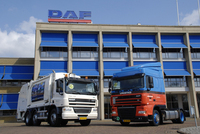DAF delivers first CF and XF105 with EEV-diesel engines
 On Thursday 17 April 2008, DAF delivered the first CF and XF105 trucks with EEV diesel engines. These Enhanced Environmentally-friendly Vehicles (EEV) emit around 50% fewer soot particles than the Euro 5 emission values, which come into effect from 2009. With the EEV diesel engines, DAF realises emission values that were previously only thought possible with gas engines. The first DAF CF with EEV engine was delivered to Roteb of Rotterdam; Jan de Rijk Logistics of Roosendaal took delivery of the first XF105 with ultra-clean EEV engine. DAF is the first truck manufacturer that can deliver all of its models in these ultra-clean versions.
On Thursday 17 April 2008, DAF delivered the first CF and XF105 trucks with EEV diesel engines. These Enhanced Environmentally-friendly Vehicles (EEV) emit around 50% fewer soot particles than the Euro 5 emission values, which come into effect from 2009. With the EEV diesel engines, DAF realises emission values that were previously only thought possible with gas engines. The first DAF CF with EEV engine was delivered to Roteb of Rotterdam; Jan de Rijk Logistics of Roosendaal took delivery of the first XF105 with ultra-clean EEV engine. DAF is the first truck manufacturer that can deliver all of its models in these ultra-clean versions.Although the Euro 5 emission standard doesn’t come into force until 2009, DAF now delivers a complete programme of diesel engines that conform to these strict emission levels. Compared with the Euro 1 standard of around 15 years ago, these engines produce around 75% less nitrogen oxides and about 94% fewer particulates. By applying DAF SCR technology in combination with intelligent high-pressure injection system the DAF developed and produced PACCAR engines meet the low Euro 5 emission values without a soot filter.
50% fewer particulates
By equipping the Euro 5 engines with a passive soot filter, particulate emissions can be further reduced by up to 50% to a value of around 0,015 gram/kWu. That is even about 25 per cent under the EEV standard. This means the diesel engine is as clean as the gas engine and it has a number of intrinsic advantages: a higher efficiency, a higher reliability and durability and lower operational costs.
“It is therefore in our view incomprehensible that there are town and regional councils that insist on gas engines for public transport or public cleansing services,” said Aad Goudriaan, President of DAF Trucks N.V., during the official handing over of the first CF and XF105 EEV trucks. “We believe that authorities should prescribe emission levels and not technology.”
DAF supplies the 9.2 litre PACCAR PR EEV engine with power outputs from 250 to 360 hp in the DAF CF75. The 12.9 litre PACCAR MX EEV engine – with power outputs from 360 to 510 hp – is fitted to the CF85 and XF105. Moreover, the LF distribution truck is also available in an EEV version. Thanks to an extremely efficient combustion process the 160 hp LF45 realises the low EEV emission values even without a soot filter.
Roteb: the cleanest technology is an obligation
Roteb of Rotterdam has the first CF with EEV and uses it for refuse collection. “Offering Rotterdammers work and a clean city is the basis for a healthy life and environment, that is our mission,” said Peter Witvliet, Roteb’s Fleet Manager. “When we replace a truck we choose therefore the cleanest technology available, without making concessions regarding reliability. Furthermore, we are constantly on the lookout for possibilities to make our fleet even more environmentally friendly. Last year we fitted a large number of our existing DAF trucks with soot filters. We view choosing the cleanest solution as an obligation to the public.” With more than 5,000 employees, Roteb carries out diverse activities, but the most well know is public cleansing. In 2007, Roteb picked up 300,000 tons of household waste, cleaned 170,000 drains and 25% of the refuse was separated for recycling. Roteb has a fleet of 750 vehicles, including 220 trucks.
Jan de Rijk Logistics:
The first EEV-engined DAF XF105 was delivered to Jan de Rijk Logistics of Roosendaal in the province of Brabant. “As an international haulier, we chose explicitly the cleanest possible trucks,” explained Sjel Wijngaards, Director Corporate Affairs within Jan de Rijk Logistics. “Whenever we take delivery of new trucks, we go for those that meet Euro 5 emission values, which do not come into effect until 2009. When the emission of soot particles with the EEV engine can be reduced by half as much again, that means an important step towards a cleaner environment, to which Jan de Rijk Logistics also wants to make a contribution.” The environment is an important part of the ‘mission statement’ at Jan de Rijk Logistics, which was awarded its ISO 14001 certificate in 2006. “Jan de Rijk Logistics takes its responsibility towards society very seriously.”
The company began with international road haulage and later expanded into various forms of logistical operations. Today, Jan de Rijk Logistics has grown to be one of Europe’s leading logistics companies. It has around 1,100 employees, offices and storage facilities throughout Europe, and a fleet of more than 800 trucks.

